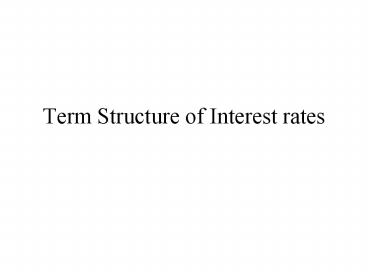Term Structure of Interest rates - PowerPoint PPT Presentation
1 / 17
Title:
Term Structure of Interest rates
Description:
i = f(default risk, expected inflation, taxes, maturity) ... Bonds and Taxes. Interest is taxed as ordinary income. municipals ... – PowerPoint PPT presentation
Number of Views:39
Avg rating:3.0/5.0
Title: Term Structure of Interest rates
1
Term Structure of Interest rates
2
Not all interest rates are equal
- We have seen since beginning of class that
different interest rates move differently - example Fed raises short term rates and
long-term rates fall - This pattern of interest rates over time is named
the term structure of interest rates
3
Determinants of interest rates
- Many things go into the investors required
returns - example liquidity, time preferences, taxes,
economy - how these things influence interest rates can be
examined by holding other things constant
4
Interest rates
- /-
- i f(default risk, expected inflation, taxes,
maturity) - obviously as default risk increases interest
rates increase
5
Bonds and Taxes
- Interest is taxed as ordinary income
- municipals
- investors concerned with after-tax rate
- rate of interest rate on munis is tehrefore lower
- Muni rate corporate rate(1-tax rate)
6
Default risk
- Risk that either interest or principla will not
be paid - bond rating agencies Moodys,SP,
- Moodys Aaa, Aa, A, Baa, BA, B, Caa, Ca, C, D
- SP AAA, AA, A, BBB, BB, B, CCC, CC, C, D
7
Bond ratings
- Rating agencies use ratio analysis, industry
analysis, company trends, and other factors in
rating firms debt.
8
Term Structure
- To examine how the interest rates move over time
we examine government securities with varying
maturities - also called yield curve
- exhibit 8.2
- show Flat, steep, inverted curves
9
Theories used to explain term structure
- Expectations Hypothesis
- simplest
- forward rate is expected future spot rate
- geometric average
- example
- problem does not fit the data
10
Liquidity Preference theory
- Investor prefer short term investments, so must
be coerced into buying longer term rates with
higher interest rates - here the forward rate exceeds the future spot rate
11
Market Segmentation Hypothesis
- Distinct markets for short term, intermediate,and
long term bonds - thus different interest rates merely reflect the
preferences of players in those separate markets
12
Preferred habitat
- Investors may prefer short term rates, but will
switch for the right price
13
- When do we see steep curves?
- When we expect future growth either inflation, or
demand. - Practically when we expect times to improve
14
- When do we see downward sloping curves?
- Usually when we expect interest rates to fall.
Hence at a business cycle top
15
- Flat curves exist when we expect relatively
constant conditions
16
Interactions
- In actuality other things are not equal.
- Example time, credit risk, and taxes are all
changing at once - spreads between hi risk and low risk change over
time as economy changes. Ex. Simultaneously the
underlying government bond rate is changing.
17
Preferred Habitat Theory































